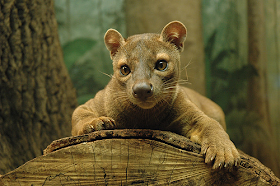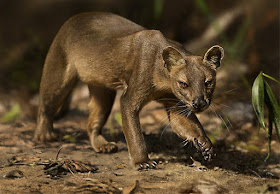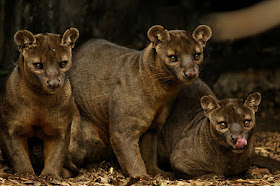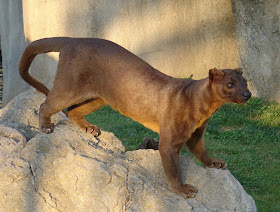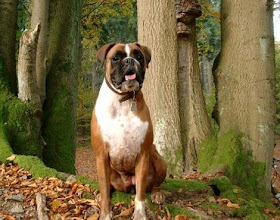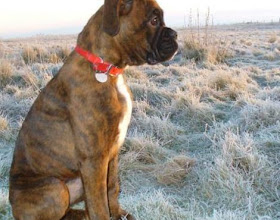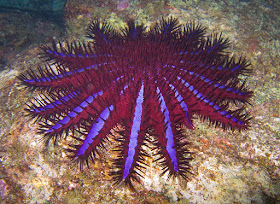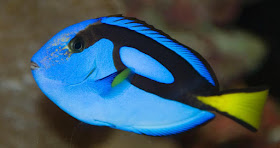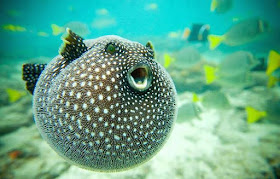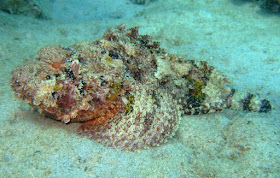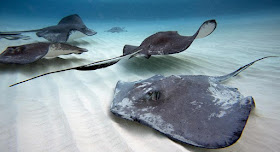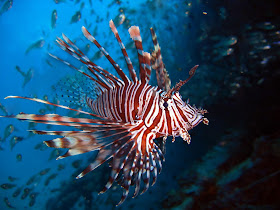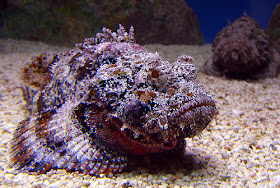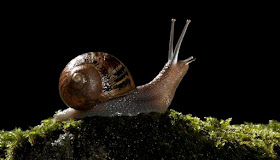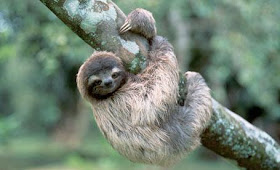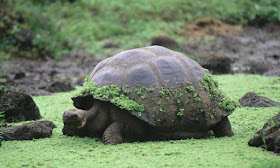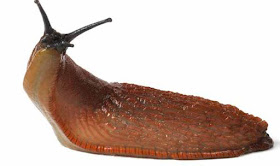Tuesday, July 28, 2015
Stone Sheep
The coat of the stone sheep is black or gray with a large, distinct rump patch. Males have large, curved spiral horns. Habitat : Mountain slopes with few trees, rugged terrain, meadows. A male's rank within the herd is determined by the size of his horns. These sheep are very wary and will flee at the hint of danger.
Chuckwalla
The chuckwalla eats fruit, leaves, buds and flowers. When the chuckwalla senses danger, it scurries between rocks and lodges itself tightly in crevices by inflating itself. male coloration may include black head, forelegs and upper trunk, and reddish-yellow toward the rear or a showy bright red body. Females are usually a much less showy gray or brown with little pattern. The young, however, are usually quite striking with a dark background color and yellow bands around the body and down onto the tail. READ MORE HERE!
Monday, July 27, 2015
Weeper Capuchin
The weeper capuchin has a coarse brown coat, tufts of hair on its head, and white markings throughout. The mating system for weeper capuchins is polygamous, with several males mating with several females. Females give birth to just one offspring.
Diet : Omnivore : fruit, insects, seeds, small vertebrates, buds, shoots, roots
Diet : Omnivore : fruit, insects, seeds, small vertebrates, buds, shoots, roots
Blue Waxbill
The Blue Waxbill is a small, slender powder-blue bird, smaller than a sparrow. The bill is short and conical and pinkish-grey in colour. The crown, back of the head and back are light brown. The rump is light blue and the face and upper breast are light blue. In the male the underparts, save for the belly centre and under-tail coverts are bright sky blue. In the female, the blue extends only onto the breast and flanks, and the belly is off-white. READ MORE HERE!
Sunday, July 26, 2015
Yellow-billed Hornbill
The yellow-billed hornbill has a yellow bill with red tip and cutting edges. The bare skin on the face and throat is red. The plumage is gray-black on the forehead to nape. It has a black mantle with a white center line. The wings and tail are black and white, and the eyes are a yellowish white. The yellow-billed hornbill can become tame very easily and is often found near human dwellings. READ MORE
Diet: Carnivore: insects and small animals
Diet: Carnivore: insects and small animals
Woylie
The Woylie is a small macropod with light brown hair and a black crest on its tail, which is 29–36 cm long. It has strong, clawed front feet which are used for digging for food and nest making. While they forage slowly, Woylies are capable of rapid movement if startled and can spring away at surprising speed.
Diet: Woylies are herbivores. They mostly feed on underground fungi but also tubers, bulbs and seeds. They can store food in their cheek pouches which contributes to the dispersal of fungal spores and seeds.
Diet: Woylies are herbivores. They mostly feed on underground fungi but also tubers, bulbs and seeds. They can store food in their cheek pouches which contributes to the dispersal of fungal spores and seeds.
Fossa
Fossa Classification and Evolution
The Fossa is a medium-sized carnivore that is found exclusively on the island of Madagascar. The Fossa belongs to the Malagasy Carnivores group which are thought to have descended from Mongoose-like ancestors that arrived on Madagascar from Africa up to 24 million years ago. The Fossa is not only one of the most ancient of the eight species found on the island but it is also the largest, meaning that the Fossa is Madagascar's largest mammalian predator. However, due to the cat-like appearance of the Fossa it was believed to be a primitive species of feline until recently. Sadly like a number of the unique animal species found in Madagascar today though, the Fossa is incredibly rare and is now considered to be endangered in it's natural habitat primarily due to habitat loss.
Fossa Anatomy and Appearance
The Fossa is the largest land predator on the island of Madagascar with some individuals growing to nearly two meters in length from their snout to the tip of their long and slender tail. The tail of the Fossa is around the same length as it's body and plays a crucial role in helping the animal to balance whilst it is leaping through the trees. The Fossa has short but dense red to dark brown fur and a small cat-like head and a dog-like snout, with large forward facing eyes and small, rounded ears. Despite being related to Mongooses, the Fossa remarkably has a number of feline features including curved, retractable claws and slightly webbed feet which both help the Fossa when it is moving about amongst the branches.
Fossa Distribution and Habitat
Like the majority of the animal and plant species that are found on the island of Madagascar, the Fossa is found nowhere else on Earth. They rely on dense, forested areas where there is not only an ample food source but also plenty of space where the Fossa can establish it's large territory. Historically, Fossas would have been found in the forest and woodland areas across the island from coastal lowlands to mountainous regions, but are today restricted to a tiny portion of their once vast natural range due to extensive deforestation throughout Madagascar. Growing Human settlements have also severely affected Madagascar's Fossa populations as they are often hunted by farmers who fear for their livestock.
Fossa Behaviour and Lifestyle
The Fossa is a solitary and nocturnal mammal that patrols territories as large as four square kilometres and marks their presence with scent released from their large anal gland. The Fossa spends the vast majority of it's life high in the trees but is known to both move about and hunt on the ground as well. They are incredibly agile at both climbing and leaping, which is greatly helped by their long and slender tail and the fact that they move about on the flat soles of their feet means that they have more balance and stability when landing precariously on branches. Although the Fossa is largely nocturnal, they are known to also hunt during the day particularly when there is a lack of food but generally spend the daylight hours resting in a hollow tree, cave or an abandoned termite mound.
Fossa Reproduction and Life Cycles
Like many solitary carnivores, Fossas only come together to mate during the breeding season in September and October. After a gestation period that lasts for around three months, the female Fossa gives birth to usually two cubs that are very underdeveloped at birth and do not open their eyes until they are between two and three weeks old. The young are cared for by their mother and begin to eat solid foods by the time they are 12 weeks old, although they are not weaned for another month. Young Fossas take almost two years to grow to their adult size and then another two until they are able to reproduce themselves. They can live for up to 17 years although many reach much younger ages.
Fossa Diet and Prey
The Fossa is the largest carnivorous mammal on Madagascar and therefore survives by only eating other animals in the surrounding forest. The Fossa has evolved perfectly to the hunting and consumption of Lemurs and in fact, more than half of the Fossa's diet is comprised of them. They will also eat Lizards, Frogs, Rodents, Birds and Reptiles to supplement their diet along with small domestic animal such as pigs and poultry. Hunting under the cover of night means that the dark coat of the Fossa is perfectly camouflaged into the dense surrounding forest so they are able to stalk their prey silently in the trees before leaping powerfully to capture it. The retractable claws of the Fossa means that they are always at their sharpest for catching prey as they are not blunted by being constantly walked on.
Fossa Predators and Threats
Due to the fact that the Fossa is the largest natural predator in Madagascar, it has no predators itself (with the rare exception of being snapped up by a stray Crocodile). Humans pose the biggest threat to the Fossa as they have not only hunted them in fear of their livestock but have also completely decimated 90% of the Fossa's once vast natural range. Deforestation for both the logging of the rare tropical timber and also to clear land for agriculture has led to enormous declines in the wild population numbers. Due to the fact that Fossas not only require large solitary home ranges but they are also relatively slow at developing it is thought that numbers will continue to fall.
Fossa Interesting Facts and Features
The Fossa tends to measure around a metre long with the same length tail on top of that but, in recent years fossils of the now extinct Giant Fossa has been uncovered in the jungles of Madagascar, with the biggest Giant Fossa fossil measured nearly six meters in length and was thought to have weighed around 17 kg! The Fossa is well known for its fierce and dominant approach to hunting as it is extremely rare that it's intended prey will successfully escape. The Fossa can run unbelievably quickly and added to it's incredible agility in the tree tops, once a meal has been spotted the Fossa is very adept at then catching it.
Fossa Relationship with Humans
When early explorers first arrived on Madagascar there would have been the most incredible array of unique fauna and flora, much of which is now extinct today. Since their arrival Humans have exploited one of the world's largest islands leaving just 10% of the tropical forest cover that would have historically stretched across the country. Land clearance for agriculture such as palm oil plantations and deforestation of the unique tropical trees has led to drastic declines in the population numbers of numerous species, including the elusive Fossa. They are also hunted by farmers who want to protect their livestock and also by some who (unfairly) believe that they are of danger to people.
Fossa Conservation Status and Life Today
Today, the Fossa is listed by the IUCN as being an Endangered animal species and therefore one that is at risk of becoming extinct in it's natural environment in the near future. Although national parks and reserves do exist on the island, none are large enough to ensure that a decent sized Fossa population can survive as each individual requires a relatively large territory and there is simply too much competition. There are thought to be less than 2,500 Fossa individuals left in the wild of Madagascar.
Boxer Dog
Boxers are a bright, energetic and playful breed and tend to be very good with children. They are active dogs and require adequate exercise to prevent boredom-associated behaviors such as chewing or digging.
Boxers have earned a slight reputation of being headstrong, which can be related to inappropriate obedience training. Owing to their intelligence and working breed characteristics, training based on corrections often has limited usefulness.
Boxers, like other animals, respond much better to positive reinforcement techniques such as clicker training, which affords the dog an opportunity to think independently and to problem-solve.
Boxers were originally a docked and cropped breed, and this tradition is still maintained in some countries. However, due to pressure from veterinary associations, animal rights groups and the general public, both cropping of the ears and docking of the tail have been prohibited in many countries around the world.
Saturday, July 25, 2015
Zorilla
Zorilla, small, carnivorous, nocturnal mammal, Ictonyx striatus, of the weasel family, found in dry regions of Africa. It is also called striped weasel and striped polecat. Although it strongly resembles the North American skunk, a member of the same family, it is more closely related to the true polecat of Eurasia. The zorilla has thick fur with black and white markings, and a long, bushy tail. Its anal glands secrete a pungent fluid that can be ejected as a defense against predators. It is avoided by other animals. It lives in rocky crevices and hunts by night, feeding on small reptiles and rodents.
Indian Red Admiral
The Indian red admiral, V. indica, is found in the Canary Islands as well as India and is distinguished by black at the apex, with subapical white spots and a discal red band. Hindwing dark brown, unmarked, except for the black-spotted red margin. Wings have a golden and bronze sheen, especially near the bases. Underside: dark brown with fine grey, greenish, brown and black markings, which aid in camouflage. READ MORE
Friday, July 24, 2015
Pleasure of Cat Massage
Want some stress releasing massage. Watch this video and get relaxed from your whole day work!
Aardwolf
The aardwolf is slightly larger than a jackal or a fox and has long, slender legs and a long neck. Its sloping back is not as pronounced as in the three other hyaena species. The background colour of the body varies from yellowish-white to rufous. The throat and underparts are paler and can reach a greyish-white color. There are three vertical black stripes on the body and one or two diagonal stripes across the fore- and hindquarters.
The aardwolf's favourite food is insects, especially termites, which they help to control. Aardwolves cannot kill livestock, yet many aardwolves are killed each year because people believe they kill lambs. They are also killed indirectly through insecticide spraying. Aardwolves are family oriented, with males and females living together in a territory.
The aardwolf's favourite food is insects, especially termites, which they help to control. Aardwolves cannot kill livestock, yet many aardwolves are killed each year because people believe they kill lambs. They are also killed indirectly through insecticide spraying. Aardwolves are family oriented, with males and females living together in a territory.
Thursday, July 23, 2015
Dog with it's ball machine
A video showcasing how a simple idea can make
your cute little dog very happy. Jerry
just can’t get enough of chasing a ball. The problem is he always needs
someone to through it for him, or does he? Luckily Jerry has a very
smart owner he designed and built an automatic ball machine that fires
the tennis balls for Jerry to go and chase. Once he’s retrieved the
ball he simply drops it back into the machine and the game continues.
It’s a great idea that’s been well engineered with excellent safety
features to make sure nothing goes wrong. This is a great video that
all dog lovers will enjoy.
Wednesday, July 22, 2015
5 Coolest Animals on Earth
1. Lobster Moth Caterpillar - The caterpillar features spindly forelegs and a swollen abdomen that curves up at the end, resembling a lobster tail. If the Lobster Moth Caterpillar is provoked, it spreads its front legs and arches its head back, possibly spraying formic acid. READ MORE HERE
2. Albino Peacock - The peacock "tail", known as a "train", consists not of tail quill feathers, but highly elongated upper tail coverts. These feathers are marked with eyespots, best seen when a peacock fans his tail. READ MORE HERE
3. Peacock Spider - Peacock spiders are venomous. But that doesn’t mean they’re dangerous to humans: Their little jaws are so tiny that they couldn’t even puncture our skin. We’re safe, but crickets and other spiders are not. Like all jumping spiders, the peacock spiders don’t build webs. READ MORE HERE
4. Giant Panda - Adult giant pandas are generally solitary, but they do communicate periodically through scent marks, calls, and occasional meetings. Offspring stay with their mothers from one and a half to three years. The giant panda has lived in bamboo forests for several million years. It is a highly specialized animal, with unique adaptations. READ MORE HERE
5. Falabella - Falabellas are sweet natured and enjoy being with children, adults and seniors. Their small size makes them easy to handle. They are easy to train to drive and fun to show. They can also provide family enjoyment as a beloved pet or companion for anyone, from tots to teens and adults, foals are especially adorable and affectionate making for a very unique and precious equine. They are versatile in many ways and can do all the things that any Miniature Horse can do. Most can be ridden by small children. They are quite intelligent and can be trained to do so many thing. They are strong for their size and driving them is very popular, especially in shows and parades. READ MORE HERE
2. Albino Peacock - The peacock "tail", known as a "train", consists not of tail quill feathers, but highly elongated upper tail coverts. These feathers are marked with eyespots, best seen when a peacock fans his tail. READ MORE HERE
3. Peacock Spider - Peacock spiders are venomous. But that doesn’t mean they’re dangerous to humans: Their little jaws are so tiny that they couldn’t even puncture our skin. We’re safe, but crickets and other spiders are not. Like all jumping spiders, the peacock spiders don’t build webs. READ MORE HERE
4. Giant Panda - Adult giant pandas are generally solitary, but they do communicate periodically through scent marks, calls, and occasional meetings. Offspring stay with their mothers from one and a half to three years. The giant panda has lived in bamboo forests for several million years. It is a highly specialized animal, with unique adaptations. READ MORE HERE
5. Falabella - Falabellas are sweet natured and enjoy being with children, adults and seniors. Their small size makes them easy to handle. They are easy to train to drive and fun to show. They can also provide family enjoyment as a beloved pet or companion for anyone, from tots to teens and adults, foals are especially adorable and affectionate making for a very unique and precious equine. They are versatile in many ways and can do all the things that any Miniature Horse can do. Most can be ridden by small children. They are quite intelligent and can be trained to do so many thing. They are strong for their size and driving them is very popular, especially in shows and parades. READ MORE HERE
Tuesday, July 7, 2015
7 of The Most Poisonous Fishes in the Sea
You might think that the most dangerous animals on earth are found on land, but you’d be surprise to find some scary, but sometimes beautiful, dangerous creatures lurking in the water. A few fish species are known for their poison, in fact there have been a few cases where people have died because if them. Below are the most poisonous fishes that you should keep an eye out for the next time you’re swimming or diving in open waters.
Crown of Thorns
This is names after exactly how it looks like, a big crown of thorns. They’re actually related to the starfish, but they’re poisonous. Their bodies are covered in thousands of venomous spikes. a sting from their spines can cause intense pain, swelling, and redness.
Surgeonfish
Although they look absolutely harmless, Surgeon fishes have spines that are dormant when they’re not threatened. The fish uses this by sticking the spines out like tiny knives. Their spines are highly poisonous, causing extreme pain and hypertension. You can even dies of hypovolemia because of a sting.
Pufferfish
Although they are extremely poisonous, Pufferfishes actually can’t inject poison into other creatures. The danger is when you eat them. A powerful toxin called tetrodotoxin is found in a number of their organs, including the liver, skin, and intestines. Even though they are poisonous, they’re still prized as a delicacy, and only certified chefs and restaurants are allowed to serve them.
Scorpionfish
The Scorpionfish is related to two other very poisonous fishes, the lionfish and stonefish. Their prickly skin and fins carry its poison. a single sting from this fish results to swelling and extreme pain, which spreads throughout the whole area in a very short time. Scorpionfishes are commonly seen in warmer, tropical waters.
Stingray
Stingrays can get pretty aggressive when provoked. They’d whip out their venomous tails and try to sting their opponents with it. There are usually seven spines on their tail, sometimes more. If the spine breaks, it often gets lodged into the flesh, causing a lot of pain and extreme bleeding.
Lionfish
One of the most beautiful, but deadly, fishes in the sea, the lionfish has spines on its dorsal side that it uses to defend itself. They’re non-aggressive and timid by nature and would never attack. Envenomation often only happens when you get too close and would hit its spine. The poison results to breathing problems, vomiting, headache, severe pain, and even paralysis of the cardiac muscles.
Stonefish
This fish is a venom storehouse. Glands found at the bottom of their dorsal fin keeps the potent venom and are released through 13 needle-like spines. Most stonefish victims end up injuring themselves because this fish is also a master of camouflage and it’s difficult to see them next to rocks and stones on the sea bed.
Monday, July 6, 2015
6 of The Slowest Animals On The Planet
Have you been watching too many agile and fast moving predators chasing after dinner in those wildlife shows? Well, here’s a little change of pace. Although most animals would prefer to be able to move fast, especially when it’s time to run or chase after food, not all animals are built to speed. Here are some of the slowest animals in the wild.
Garden Snail
No surprise here. The award for slowest moving creature in the planet goes to the garden snail. They’re a specie of land snail that’s very common, so common in fact you could just find them in your garden. They move at a speed of 1.3 cm per second, which is roughly around 78 cm a minute or 47 meters an hour.
Sloth
They’re cute, but they’re very slow. Sloths actually got their name from their slowness. They can move to around 2 meters per minute. They spend most of their time on top of trees in the wild where they are less vulnerable, feeding on fruits and nuts, so you’d usually never see these guys on the ground.
Starfish
You wouldn’t expect these beautiful creatures to move, but they actually have tiny tentacles that help them go from point A to point B at a distance of 15 cm in a minute. Starfishes move around the sea floor looking for food or a place they can hide. If they stay too close to the shore, the need to move to the water when the tide goes down to avoid getting too dry.
Giant Tortoise
Not only are they slow, they also live for a very long time. Giant tortoises are said to have a lifespan of about 200 years, so they’re never in a hurry. They can also get pretty heavy, reaching a weight of 300 kg when they mature.
Koala Bear
Koala Bears are one of the most adorable animals on the plant. But be warned, they can get a bit aggressive and even bit or urinate on you. Thankfully, they move very slowly, so don’t expect to get chased away by one.
Slug
What seems to look like a homeless snail is actually an animal of its own. Slugs are slimy little animals that more at a maximum speed of 0.3 km/h. Like snails, they also leave a train of slime along the way. One of the most amazing features that slugs have is their amazing, vibrant colors.



















